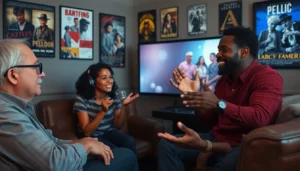When someone greets you with “What’s cooking, good looking?” it’s more than just a casual inquiry about dinner plans. It’s a playful way to connect, sparking curiosity and inviting conversation. This phrase has become a staple in friendly banter, often used to lighten the mood and bring smiles.
In a world where small talk can feel mundane, this cheerful greeting stands out. It’s a chance to showcase personality and creativity in responses. Whether it’s a witty comeback or a heartfelt reply, how one responds can set the tone for an engaging interaction. Exploring the various ways to reply not only enhances communication skills but also brings a sense of fun to everyday exchanges.
Overview of “What’s Cooking Good Looking”
“What’s cooking, good looking?” serves as a light-hearted greeting that enhances social interactions. This phrase invites playful banter, encouraging quick exchanges that break the ice. Its informal nature allows individuals to showcase their personality, making it memorable in everyday conversation.
Responses to this greeting can vary widely, reflecting one’s sense of humor or creativity. For instance, a simple, humorous comeback like “Just stirring up some trouble!” or a witty reply such as “Cooking up some mischief!” can spark laughter and further dialogue. These responses nurture connections and provide opportunities to engage others more deeply.
Utilizing this phrase in social situations strengthens communication skills and fosters an enjoyable atmosphere. It transforms ordinary exchanges into engaging moments, enriching relationships and promoting camaraderie among friends and acquaintances. As such, learning to respond effectively to “What’s cooking, good looking?” proves essential for enhancing interpersonal connections.
Key Themes in the Response

Responses to the phrase “What’s cooking, good looking?” reflect various themes that enrich communication. Key areas of exploration include culinary inspiration and cultural impact.
Culinary Inspiration
Responses often draw on food themes, showcasing culinary interests and creativity. Individuals may reference favorite dishes, cooking methods, or ingredients. For instance, someone might respond with, “Just whipped up a delicious lasagna,” or, “Trying out a new taco recipe.” These replies not only reveal personal preferences but also invite further conversation about cooking techniques and flavor combinations. Engaging in this way fosters a shared appreciation for food and the culinary arts.
Cultural Impact
The greeting transcends regional boundaries, promoting cultural exchanges. Responding to “What’s cooking, good looking?” can also showcase regional cuisines or cultural traditions. A person from New Orleans might mention gumbo, while an Italian might talk about homemade pizza. Such responses highlight the diversity of culinary practices and encourage participants to share experiences tied to their cultural backgrounds. This dialogue fosters greater understanding and appreciation of global food practices, enriching social interactions.
Analysis of Audience Reception
Audience reception to “What’s cooking, good looking?” reveals varied responses, ranging from enthusiastic engagement to thoughtful critiques. Understanding these perspectives highlights the phrase’s impact on social dynamics and communication skills.
Positive Feedback
Positive feedback primarily focuses on the phrase’s ability to create connections. Many individuals express enjoyment when using or hearing this greeting. They appreciate its playful nature and find that it often leads to more relaxed and enjoyable interactions. Respondents frequently mention the phrase’s effectiveness in breaking the ice, especially in new or awkward social situations. The emphasis on culinary themes allows for lively discussions about food preferences and cooking tips, fostering a sense of community. Participants also report that it has been instrumental in enhancing their social interactions by producing laughter and promoting friendly banter.
Constructive Criticism
While many appreciate the greeting, constructive criticism often highlights its occasional overuse or perceived cliché status. Some individuals feel that reliance on the phrase can seem insincere, especially if used repetitively in casual conversations. Critics argue that depending heavily on it may hinder more profound engagement or limit opportunities for genuine connection. Additionally, in certain contexts, the phrase might not resonate well, particularly in more formal or serious discussions. This feedback underscores the importance of context when employing playful language in communication, suggesting that variations in response may improve overall reception.
Comparison to Similar Works
Comparative expressions like “What’s cooking, good looking?” exist in various forms, enhancing social interactions and conversational dynamics. Other playful greetings, such as “What’s up, buttercup?” or “What’s shaking, bacon?” serve similar purposes, fostering a light-hearted atmosphere. Each phrase uniquely reflects the speaker’s personality and establishes comfort in conversation, thereby contributing to social engagement.
Responses to these greetings often showcase a mix of humor and creativity. Just as with “What’s cooking, good looking?”, responses to “What’s up, buttercup?” can evoke smiles and laughter, encouraging further dialogue. In contrast, more straightforward greetings lack the whimsy, often leading to more perfunctory exchanges.
Culinary references also appear in similar works, illustrating the universal appeal of food in communication. For instance, “How’s it cooking?” invites dialogue about culinary experiences much like its counterpart. This showcases a mutual appreciation for food culture, resonating with audiences who enjoy discussing recipes or dining preferences.
Cultural impact plays a significant role in these greetings too. Expressions from various regions, like “What’s brew-ha-ha?” in coffee-loving communities, highlight local customs while engaging participants in cultural exchanges. Such greetings encourage exploration of different culinary traditions, thus enhancing understanding among individuals from diverse backgrounds.
Audience reception varies across these playful phrases. While “What’s cooking, good looking?” garners positive reactions, some alternatives may be perceived as overly casual or less effective in specific contexts. Context remains vital, as familiarity with the audience will indicate the appropriateness of these greetings. Overall, comparing these expressions reveals the significance of playful language in nurturing connections while also demonstrating the importance of context in communication.
Engaging with the phrase “What’s cooking, good looking?” opens up a world of playful interaction. It encourages creativity and humor in responses that can transform mundane conversations into memorable exchanges. By embracing this light-hearted greeting, individuals can strengthen their communication skills and enhance their social connections.
The culinary references embedded in the phrase invite discussions that celebrate food and culture. This shared appreciation fosters deeper dialogues and enriches relationships. While context remains crucial in determining the effectiveness of such greetings, the overall impact is clear. Playful language not only nurtures connections but also adds a delightful layer to everyday interactions.





